|
October 25, 2000 Notebook Shapiro
leaves on a high note Committee formed to select new president Faculty salaries are fifth highest Princeton's new communications director plans changes On
view at Princeton Media,
media on the wall No
more wars Shapiro
leaves on a high note
Shapiro said that he was both relieved and saddened to be leaving the helm of the university for which he cares so strongly. "Separations are difficult, especially a separation from something I've loved so much. And I have, of course, a long-term attachment to Princeton, an attachment that is now 40 years old." Faculty and administrators say they will be sorry to see Shapiro go. "He's done an extraordinary job, and I think any observer would say that the vision he's shown, the humanity, and his concern for careful planning will be very difficult for any successor to match," said provost and astronomy professor Jeremiah Ostriker.
Much of what Shapiro accomplished over his tenure related to undergraduate education and student life at Princeton. Early in his presidency, he established a program to improve the teaching of science and technology to nonscience majors. Since, he has worked to introduce a number of student and teaching programs. "If you look at the last 13 years," Shapiro said, "I think you can see a continuous record of trying to do things to expand teaching programs: everything from new academic awards for freshmen and sophomores to teaching awards for faculty to the so-called presidential teaching initiatives, which include visiting professorships, the 250th fund for innovation in teaching, new masters' programs, and the McGraw Center for Teaching and Learning. I don't think a single year has gone by when we haven't done something to lend new vitality to undergraduate education."
After an early and controversial budget-cutting mission that raised the hackles of faculty and students, Shapiro points out that he raised faculty salaries from 94 percent of the university's peer group to 104 percent. He also encouraged the development of a number of interdisciplinary research centers, which have made both faculty and graduate students particularly happy. "Such ventures as the Integrative Genomics Institute and the Center for the Study of Religion show [Shapiro's] concern to respond to new challenges in this era," said Dean of the Graduate School John Wilson. "I've been particularly pleased that he has clearly recognized how important the Graduate School is to Princeton's overall strength. He has supported the school in very important ways, such as increasing the resources that we're able to offer the students, and I think that brings the very best candidates to Princeton." Shapiro has also tried to improve diversity at Princeton, from working to hire more minorities as faculty and administrators to significantly improving undergraduate financial aid for both U.S. and international students. In 1989 the university reported the incoming freshman class - the Class of 1993 - as 56 percent male and 44 percent female; 16 percent alumni children; 20 percent minority (including African American, Asian American, Latino American, and native American); and 6 percent foreign citizens. The Class of 2004 is reported at 51 percent male and 49 percent female; 13 percent alumni children; 26 percent minority; and 9 percent foreign citizens. Shapiro oversaw the most ambitious building program in Princeton's history. Since 1999, two dorms, Patton and Blair, have undergone extensive renovations, with at least four more slated. Athletic facilities such as the new Princeton Stadium, the Weaver track, the Shea Rowing Center, and 1952 Field were built under Shapiro's watch, as were numerous academic buildings such as Fisher, Bendheim, and Wallace Halls and the Friend Center. And the $48-million Frist Campus Center, which Shapiro hopes will unite the campus community, opened its doors in September. The 250th Anniversary Campaign for Princeton, however, may be what Shapiro eventually is best remembered for. The five-year fundraising drive brought in an astounding $1.14 billion in donations, with 77 percent of alumni participating. Similarly, Shapiro will leave the university with an $8-billion endowment, up from two billion in 1988, and a legacy of steadily smaller annual tuition increases. Less tangible than buildings or professorships, but nonetheless meaningful, is a recurring theme of Shapiro's presidency, one that he has stressed particularly in the last few years of his tenure: the notion that Princeton students and alumni have a moral obligation to use their education for a higher good. In speech after speech, Shapiro has hammered home this message, an unusual one in today's world. At the 2000 Commencement, for example, Shapiro told graduates, "It will be your task to chart an ethical course that encompasses the rich human diversity of our nation and the complex realities of our rapidly broadening global society." Shapiro continues to make the point today. "Anyone who is privileged enough to have a Princeton education, and all that implies, has more moral responsibilities than someone else," he said. "My own view is that one's ethical responsibilities grow with one's knowledge and capacities. Since [student and alumni] capacities are very high, so are their moral responsibilities. It's the idea of reflecting on the fact that there might be a better way to organize our society, there might be a better way for them to live as people, there might be a better way for them to take other people's interests into account when they act. It's sensitivity, self-awareness, personal and intellectual honesty." Shapiro lists undergraduate initiatives such as new teaching programs, improved financial aid, the investment in dormitories, and the Frist Campus Center as projects that give him the most pride. He says that challenges in undergraduate education are what lured him to Princeton in the first place, and he readily ticks off the ways in which he has made an effort to see undergraduate students, such as holding regular office hours, teaching, thesis advising, making visits to residential colleges and eating clubs, and hosting frequent student breakfasts at his home. Ironically, however, it is undergraduates who give Shapiro his only low marks. "Students should have at least the illusion that the president is available to them," one junior told the Daily Princetonian. In an editorial, the Prince also criticized Shapiro's absences from campus and campus life, saying, "President Shapiro's presence at Opening Ceremonies and Commencement bookend our time at Princeton. Unfortunately, few of us had the chance to meet him - let alone see him - in between." Students' feeling of remove from Nassau Hall may be partly due to the fact that unlike presidents Robert Goheen '40 *48 and William Bowen *58, Shapiro was not a beloved or familiar faculty member before ascending to the presidency, instead coming directly from the presidency of the University of Michigan. In addition, Shapiro's personal style is far more reserved than that of the gregarious Bowen. Perhaps, too, the perception of isolation is greater than the reality. "He does go to a surprising amount of student activities," said Undergraduate Student Government president P. J. Kim '01. "When students take the initiative to ask him to come he's very responsive. Very few major university presidents do that kind of thing." There is no doubt that
Shapiro leaves the university stronger and more competitive than
it was when he arrived. With the completion of the Wythes Report
earlier this year, Shapiro leaves behind a blueprint for Princeton's
future; with the overwhelming success of the anniversary campaign,
he has, presumably, provided the money to finance that future. "I
came here awestruck at what Princeton has achieved," Shapiro
said. "I leave as president awestruck by what it really could
be." By J.C.M., with reporting by L.O. and Anne Ruderman '01
Committee formed to select new president When President Shapiro announced that he would step aside at the end of this academic year, the trustees moved quickly to form a search committee to select Princeton's 19th president. Two hours after the president's announcement on September 22, Robert Rawson, Jr. '66, chair of the executive committee of the board, sent an email to the university community explaining the composition of the committee and seeking input. "While the search committee will include in its membership wide representation of the University community," Rawson wrote, "it will also be essential for the committee to consult very broadly both on and off campus. Advice and assistance from many quarters will be sought - not least because the new President will need, upon taking office, the strong support and confidence of the entire University family." The 18-person search committee is to be composed of nine trustees, five faculty members - one from each of the academic divisions (humanities, social sciences, natural sciences, and engineering) and one nontenured faculty member - three students, and one staff member. The committee's first meeting was to be last week, coinciding with the anniversary-campaign celebration, when a number of the trustees were on campus. The following trustees will serve on the committee: Brent L. Henry '69, Dennis J. Keller '63, Spencer B. Merriweather '00, Heidi G. Miller '74, Robert S. Murley '72, Elizabeth Plater-Zyberk '72, Robert H. Rawson '66 (chair), John O. Wynne '67, and Paul M. Wythes '55 (vice chair). At press time the faculty members were in the process of being selected. According to Thomas Wright '62, vice president and secretary of the university, the Faculty Committee on Appointments and Advancements acted as a nominating committee. A ballot with the nominees was sent to the faculty on October 5. The results were expected around October 12. The students serving are P. J. Kim '01, president of the Undergraduate Student Government, Lauren Hale GS, chair of the Graduate Student Government, and Lisa Lazarus '02. Kim and Hale were selected by virtue of their positions in student government. Lazarus was chosen by Kim from 100 applicants who submitted essays about the subject. From the applications and interviews, Kim selected Lazarus, who at Princeton has served on the Human Values Forum, worked as an Orange Key guide, and spent last semester studying abroad in Santiago, Chile. Also at press time, the staff member was in the process of being selected. That person was to be chosen in an election by the entire staff of the university. The four candidates were nominated by the executive committee of the Council of the Princeton University Community (C.P.U.C.). A wide process of consultation
is expected in the search process. The first step in that consultation
was a letter from Rawson to all Princeton alumni dated September
25. In the letter, which also included a copy of the news release
announcing Shapiro's departure, Rawson asked alumni to send comments
and suggestions to the committee, addressed to 217 Nassau Hall,
or via email at pusec@princeton.edu. By L.O.
Six outstanding postdoctoral scholars are now on campus as part of the new Society of Fellows in the Liberal Arts. The scholars program, funded largely by Lloyd E. Cotsen '50, is designed to offer some of the best recent Ph.D. recipients in the humanities, social sciences, and the natural sciences a chance to further their research and teaching while infusing Princeton with fresh ideas and interdisciplinary approaches to scholarship. The fellows, called Cotsen Fellows, teach half-time in either their academic departments or in the Humanities Council. The inaugural fellows are Branden Joseph, a historian of art and architecture from Harvard who is a specialist on experimental art, including the work of John Cage, Robert Rauschenberg, and the neo-avant-garde; Danielle Fosler-Lussier, a musicologist from the University of California, Berkeley, who studies the effect of Cold War politics on European musical life, with a focus on Hungarian music and the postwar reception of Bela Bartók's work; David Chamberlain, a classicist and specialist on Herodotus from the University of California, Berkeley; Giovanna Ceserani, a classicist from Cambridge University who focuses on the 18th-century origins of the modern historiography of ancient Greece; Robert Goulding, who earned his Ph.D. in combined historical studies from the Warburg Institute at the University of London and plans a monograph on the Renaissance debate over three ancient geometrical problems; and Elisabeth Hilbink, a political scientist from the University of California, San Diego, who will teach in the Woodrow Wilson School and pursue research on the effects of institutional changes to the judiciary in civil law countries of southern Europe. Professor Alexander Nehamas
directs the society, which also includes the faculty fellows Hal
Foster in art and archaeology, Anthony Grafton in history, Simon
Levin in ecology and evolutionary biology, Susan Naquin in history
and East Asian studies, Joyce Carol Oates in the Creative Writing
Program, and Michael Wood in English.
Faculty salaries are fifth highest The average full-professor salary at Princeton rose 4.4 percent last academic year, from $114,900 to $120,000, according to data collected and published last spring by the American Association of University Professors (A.A.U.P.). The national average was $76,200. Last year's inflation rate was 2.7 percent. Princeton is one of 29 universities and colleges that paid its full professors more than $100,000 on average and was the fifth highest-paying university in the country, down from fourth last year. Universities paying their full professors more than Princeton in 1999 - 00 were Rockefeller University, Harvard, University of Colorado Heath Sciences Center, and Stanford. The average salary paid to associate professors at Princeton last year was $71,9000; assistant professors $56,000; and instructors $49,200. The national average for associate professors was $55,300; assistant professors $45,500; and instructors $34,700. At Princeton, as at virtually every other university, a gender discrepancy continues to exist between the average salary paid to men and that paid to women. Male full professors at Princeton earn an average of $120,500, while female full professors earn $117,100. Male associate professors earn an average of $73,700, and females $69,400; male assistant professors earn $56,800, and females $54,700. According to information collected from A.A.U.P., there were 367 male full professors and 59 female at Princeton.
Average salaries of full professors in the Ivy League Harvard $128.9 Faculty
File
in New York. He also published two new books: One Universe: At Home in the Cosmos (John Henry Press) and The Sky Is Not the Limit: Adventures of an Urban Astrophysicist, a memoir (Doubleday). Whether in the planetarium, the classroom, or in print, Tyson has spent a lifetime demystifying the cosmos for nonscientists - "bringing the universe down to earth," he says. He believes astrophysics is a particularly accessible science, "because the universe is right up there, staring back at you." This semester, after two years' intense preparation for the planetarium opening, Tyson is enjoying a brief sabbatical on campus. He will pursue research on "the structure of the Milky Way galaxy, and the formation of stars in other galaxies, especially dwarf galaxies." In the spring, he will once again teach, with colleagues J. R. Gott and Michael Strauss, Astrophysical Sciences 203, The Universe. "'The Universe,'" Tyson muses. "Now there's an audacious title!" The course "doesn't aim to make everybody a scientist - what a boring world that would be. I want to make sure that, whatever our students do in the future, they can look up and appreciate what they see." Research and teaching
at Princeton "bring energy to my work at the planetarium,"
says Tyson. "And working at the planetarium makes me a better
teacher, because every day I'm thinking about innovative ways to
explain the cosmos so people will understand." By Caroline Moseley
Theatre Intime reopened
after a three-month renovation in which the lobby was refurbished,
seats replaced, and auxiliary areas improved. The first show of
the season, the farce Noises Off, by Michael Frayn, featured, left
to right, Cliff Sofield '02, Ali Freda '02, Matt Roman '03 (on floor),
Tommy Dewey '01, and Adam Friedman '0.
Princeton's
new communications director plans changes Ilauren Robinson-Brown '85 joined the university as director of communications in August. She succeeded Justin Harmon '78, who left for a position at Wesleyan University. Robinson-Brown majored in English, earned a certificate in Afro-American studies, had leadership roles in the Organization of Black Unity and the Black Thoughts Table, and was a senior editor of The Vigil and a disc jockey for WPRB. After earning a master's degree in journalism from Columbia University and working for a Newark, New Jersey-based cable company, she worked as a reporter at various newspapers, including the Newark Star-Ledger, the Dallas Times-Herald, and the Boston Globe. In December 1994 she became director of communications for the state of New Jersey, serving as press secretary for the department of state. Six months later she was promoted to assistant commissioner, and in January 1998 she was promoted to assistant secretary of state. In that job she was the department's second-ranking official and managed its daily operations, with emphasis on communications and strategic projects. She recently answered a few questions from PAW: Why did you come to Princeton? This is the toughest, so I'll answer in several ways. The committee was searching for someone who understood the university, who could articulate its mission and vision, who could relate well to all members of its diverse community, who understood the media and politics, who was a solid manager and who was a strategic yet creative thinker. They determined that I could do all of those things. I was 16 when I was admitted and entered college so, looking back, I understand that Princeton took a calculated risk and made a major investment in me simply because good people believed in my value and in my potential. When the opportunity presented itself, I had to come back to Princeton because hard work is the best way imaginable to repay an institution that has played such a pivotal role in my life. Since Princeton is committed to public service, I think my experiences as a journalist, a communicator, and a state official become tremendously valuable as the university both strives to positively influence the public sector and to inspire our students to make even greater contributions in this area. Did you expect to be hit with such a big story (Shapiro's decision to step down) so early in your career? I never would have imagined that our tiny office would be dealing with so many major issues at once - from President Shapiro's announcement of his planned resignation to U.S. President Clinton's visit [on October 5] - but I guess most of my jobs have been baptism by fire. I'm a risk taker and jumping right in is the best way to learn. Are you making any major changes in the office? The Office of Communications
will change under my leadership. We've created a mission statement
and will develop other tools that will help the university community
better understand what we do and the value of our service. First,
we're getting organized internally so that we have the capacity
to meet new expectations. Next, we'll become more visible externally
by fully utilizing tools such as the Web and digital technology.
But we've already had a great start with the redesign of the Princeton
Weekly Bulletin, the introduction of new media tools such as an
experts database and Research Notes, which focuses on the work of
our wonderful faculty, and you will see more new and exciting publications
to augment the more traditional materials we produce. By L.O.
Rembrandt's etching Beggars
Receiving Alms at the Door of a House is one of the works on
display through November 5 in the Art Museum in connection with
an exhibition of Dutch prints used in Thomas Kaufmann's course The
Age of Rembrandt. This etching is one of a large group of prints
and drawings of peasants that the artist drew from life, and was
etched in 1648, the year the Netherlands finally won its independence
from Spanish rule. Media,
media on the wall
A joint venture among undergraduates, graduate students, and faculty members, SHRIMP has been studying the technology and the artistry underlying scalable display walls for the past six years. To date, most of their work has been focused on an 18-by-81/2-foot display wall constructed in a computer science laboratory. However, an undergraduate course created two years ago focused its efforts on the construction and planning of a display wall to be shared by the entire university community in the Frist Campus Center. Taught by Ben Shedd, a visiting senior research scholar and an Academy Award-winning filmmaker, the course, called Visual and Audio Design for Large Scale Computer Displays, has explored the function, aesthetics, and ethics of this unique digital space. While the class brainstormed a number of uses for such a space - a virtual aquarium, an interactive bulletin board, a backdrop for performing arts groups, a game center, a display for simulcast productions or video conferencing, a digital art gallery, a life-size "Campus Cam" - no final decisions have been made. Ultimately, a student
organization composed of Shedd's course's graduates will be in charge
of regulating the wall's function and content. As the display wall's
official demo (which can be found at http://www.princeton.edu/~dhammell/home.html)
states, the "sky's the limit."
By Andrew Shtulman '01 An ecology and evolutionary biology colloquium on September 27 featured Duke University professor James Clark, who spoke about seed dispersal and tree migration. Angela Davis, author and activist and professor at the University of California, Santa Cruz, spoke on September 29 about human rights and the economic impact of America's growing prison system. The occasion marked the 30th anniversary of the Third World Center. Sister Helen Prejean, author of the book on which the movie Dead Man Walking was based, spoke on September 30 at the University Chapel about the dilemmas of the death penalty. Prejean was at a conference that was planned by local faith-based organizations. On October 2 the Crossroads of Religion and Politics lecture series began. Richard Madsen, a sociology professor at the University of California, San Diego, discussed the topic China's Catholics: Tragedy and Hope in an Emerging Civil Society. Juan M. Maldacena *96,
a professor of physics at Harvard, spoke on October 15 on gravity,
black holes, and strings. A fellow of the MacArthur Foundation,
Maldacena works in high-energy physics and string theory.
No
more wars
"The money offers me an opportunity to institutionalize the whole study of self-determination, something Prince Hans-Adam is very interested in," Danspeckgruber said. "We will create an endowment, and I see in the future of the institute diverse research projects that cover the Balkans, East Timor, and other areas. I want to really push the envelope. If we can come in with 50 new ideas, even if some are wrong, some will be right. We want to do this for the sake of mankind, so we don't have to resort to wars." Currently, three projects are underway. One, launched by Danspeckgruber and Associate Professor Stephen Kotkin, director of the Russian Studies program, is exploring state power, borders, and self-governance in the region of the former Soviet Union. The project is expected to conclude with findings and recommendations presented at a conference in 2001. In another project, Danspeckgruber is working with Professor Michael Doyle, director of the Center of International Studies; Professor Jeffrey Herbst, chairman of the politics department; and Professor Gilbert Rozman of the sociology department. Together, they hope to develop strategies to prevent and manage crises of self-determination. A third project has researchers looking for solutions to the problem in Kashmir, where separatist groups have mounted an 11-year struggle against Indian rule. An ongoing project for
the Institute is the search for a peaceful solution to the situation
in the Balkans.
During the search for a new vice president of computing and information technology, Provost Jeremiah Ostriker has assumed more direct responsibility for CIT leadership along with two CIT directors, David Koehler and Steven Sather. Koehler has oversight for administrative computing and infrastructure. Sather directs academic computing and customer service. Judy McCartin p'84, an honorary member of the classes of 1928, 1931, 1932, 1936, and 1937, retired at the end of September from her job as associate director of Annual Giving. She first came to Princeton in 1980 as a volunteer when her daughter, Kate, entered as a freshman. In 1984, she took a paid position in development relations, and in 1989 she moved to Annual Giving to work with the classes of the post-50th reunions era. William Hardt '63, director of Annual Giving, said he would miss McCartin. "I think it is fair to say that Judy has had a wonderful effect with the classes she's worked with, and not only in the obvious way in terms of their Annual Giving campaigns. She cared for them in every way, their reunions, memorial services, a whole range of things." McCartin leaves the university to work with William Scheide '36 in his philanthropic endeavors. Fall bicker took place the week of September 25. Tower Club accepted seven new members; Ivy took in 12, and Cap & Gown 15. Bicker was dry this year, but many a new member at the clubs was given a champagne toast.
|
|||||||||||||

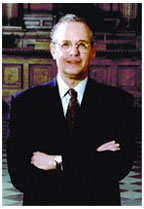 Five
days after his announcement that he would step down as Princeton's
18th president, Harold T. Shapiro *64 reflected on his decision.
"It's good for me and good for the institution," he said.
"I felt it was a good time for me, since I did want to return
to teaching here at Princeton, and to writing; and I also think
it's a good time for the institution. We're doing well by most measures
and there are many opportunities left for my successor."
Five
days after his announcement that he would step down as Princeton's
18th president, Harold T. Shapiro *64 reflected on his decision.
"It's good for me and good for the institution," he said.
"I felt it was a good time for me, since I did want to return
to teaching here at Princeton, and to writing; and I also think
it's a good time for the institution. We're doing well by most measures
and there are many opportunities left for my successor." Dean
of the Faculty Joseph Taylor, a physics professor, echoed Ostriker.
"I think it's been a wonderful presidency. I've immensely enjoyed
working for him and working with him," Taylor said. "In
the second half of his 13 years, more or less, he took a very strong
leadership role, not only in the obvious outward aspects of the
Anniversary Campaign for Princeton, but actually in looking for
places on campus where new initiatives should be taken, where new
directions should be foremost in our minds, and where we should
be taking some risks and doing things we were not doing already.
I think he has focused on the idea that an institution like Princeton
should always be evolving. He has been out in front in recognizing
that now is a good time, for example, to start the initiative in
genomics; or that now is a good time to be looking for ways to do
something special in the humanities and liberal arts, as he did
in the Society of Fellows Program."
Dean
of the Faculty Joseph Taylor, a physics professor, echoed Ostriker.
"I think it's been a wonderful presidency. I've immensely enjoyed
working for him and working with him," Taylor said. "In
the second half of his 13 years, more or less, he took a very strong
leadership role, not only in the obvious outward aspects of the
Anniversary Campaign for Princeton, but actually in looking for
places on campus where new initiatives should be taken, where new
directions should be foremost in our minds, and where we should
be taking some risks and doing things we were not doing already.
I think he has focused on the idea that an institution like Princeton
should always be evolving. He has been out in front in recognizing
that now is a good time, for example, to start the initiative in
genomics; or that now is a good time to be looking for ways to do
something special in the humanities and liberal arts, as he did
in the Society of Fellows Program." Dean
of the College Nancy Weiss Malkiel agrees. "I think that the
vitality of undergraduate education here is enormously impressive,
thanks in great measure to the attention and resources that President
Shapiro has given to it. I think we've benefited enormously, whether
you're talking about curriculum development resources, or the visiting
professors for distinguished teaching, or the creation of the center
for teaching and learning, or the growth of the Freshman Seminar
program, or the institutional investment in study abroad. There's
a long list. He's just been enormously fruitful."
Dean
of the College Nancy Weiss Malkiel agrees. "I think that the
vitality of undergraduate education here is enormously impressive,
thanks in great measure to the attention and resources that President
Shapiro has given to it. I think we've benefited enormously, whether
you're talking about curriculum development resources, or the visiting
professors for distinguished teaching, or the creation of the center
for teaching and learning, or the growth of the Freshman Seminar
program, or the institutional investment in study abroad. There's
a long list. He's just been enormously fruitful." The
millennium started off with a big bang for astrophysical sciences
professor Neil de Grasse Tyson. The dazzling new Hayden Planetarium,
of which he is director, opened in the American Museum of Natural
History's Rose Center for Earth and Space
The
millennium started off with a big bang for astrophysical sciences
professor Neil de Grasse Tyson. The dazzling new Hayden Planetarium,
of which he is director, opened in the American Museum of Natural
History's Rose Center for Earth and Space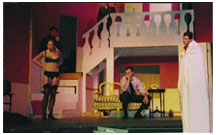
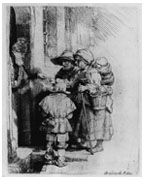 On
view at Princeton
On
view at Princeton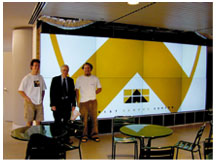 At
one end of the new campus center, a group of tables and chairs are
arranged facing a television screen, and at the other end, a group
of tables and chairs are arranged facing a wall - but not just any
wall. It's a high-resolution digital display wall. This 18-foot-wide,
six-foot-high computer screen containing 6,291,456 pixels is 108
times the size of a normal desktop computer screen. It was constructed
as part of an ongoing research project in the Computer Science Department
known as SHRIMP, or Scalable High-performance Really Inexpensive
Multi-Processor.
At
one end of the new campus center, a group of tables and chairs are
arranged facing a television screen, and at the other end, a group
of tables and chairs are arranged facing a wall - but not just any
wall. It's a high-resolution digital display wall. This 18-foot-wide,
six-foot-high computer screen containing 6,291,456 pixels is 108
times the size of a normal desktop computer screen. It was constructed
as part of an ongoing research project in the Computer Science Department
known as SHRIMP, or Scalable High-performance Really Inexpensive
Multi-Processor. 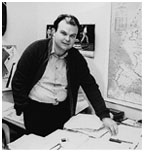 The
university recently received a $12-million gift from Prince Hans-Adam
II, of the tiny municipality Liechtenstein, which is tucked between
Switzerland and Austria, to create an institute that explores the
issues of self-determination. The prince previously had given Princeton
money for a research program on the same subject. Wolfgang Danspeckgruber
(right), a lecturer in the Woodrow Wilson School, will direct the
new institute, which will be called the Liechtenstein Institute
on Self-Determination.
The
university recently received a $12-million gift from Prince Hans-Adam
II, of the tiny municipality Liechtenstein, which is tucked between
Switzerland and Austria, to create an institute that explores the
issues of self-determination. The prince previously had given Princeton
money for a research program on the same subject. Wolfgang Danspeckgruber
(right), a lecturer in the Woodrow Wilson School, will direct the
new institute, which will be called the Liechtenstein Institute
on Self-Determination.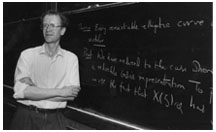 Andrew
Wiles, famous for having solved the mathematical puzzle Fermat's
Last Theorem in 1993, was elected to the Royal Society of Canada,
the Canadian Academy of the Sciences and Humanities. He will be
inducted next month. On another note, Wiles, who came to Princeton
in 1982, is the subject of a new musical by the composer Joshua
Rosenblum and his wife, Joanne Lessner. The musical, called Fermat's
Last Tango, went into rehearsal a few days ago and opens at the
York Theater in New York on December 7.
Andrew
Wiles, famous for having solved the mathematical puzzle Fermat's
Last Theorem in 1993, was elected to the Royal Society of Canada,
the Canadian Academy of the Sciences and Humanities. He will be
inducted next month. On another note, Wiles, who came to Princeton
in 1982, is the subject of a new musical by the composer Joshua
Rosenblum and his wife, Joanne Lessner. The musical, called Fermat's
Last Tango, went into rehearsal a few days ago and opens at the
York Theater in New York on December 7. Theodore
Ziolkowski, professor of Germanic languages and literatures, was
awarded the order of Merit (First Class) by the Federal Republic
of Germany for his success at "combining teaching, research,
and university administration," and for acquainting "countless
young Americans with Germany, her language, history, and culture."
Theodore
Ziolkowski, professor of Germanic languages and literatures, was
awarded the order of Merit (First Class) by the Federal Republic
of Germany for his success at "combining teaching, research,
and university administration," and for acquainting "countless
young Americans with Germany, her language, history, and culture." Anyone
who's been awake at all this year cannot fail to have noticed that
the topic of education in America is constantly in the news, whether
it's about the poor performance of schoolchildren or the lack of
qualified teachers in classrooms. A story that ran in the New York
Times in August reported that many states, in a effort to fill their
empty teaching slots, offer teacher-training modeled on Teach for
America, the program that Wendy Kopp '89 developed out of her senior
thesis. For her program, Kopp hires recent graduates, trains them
over a summer, and places them in schools clamoring for teachers.
Now, several states and some cities have instituted short-term training
programs as well. Teach for America continues to thrive; Kopp, who
last spring received an honorary degree from Princeton, said that
her program this year received 10 percent more applicants than the
year before.
Anyone
who's been awake at all this year cannot fail to have noticed that
the topic of education in America is constantly in the news, whether
it's about the poor performance of schoolchildren or the lack of
qualified teachers in classrooms. A story that ran in the New York
Times in August reported that many states, in a effort to fill their
empty teaching slots, offer teacher-training modeled on Teach for
America, the program that Wendy Kopp '89 developed out of her senior
thesis. For her program, Kopp hires recent graduates, trains them
over a summer, and places them in schools clamoring for teachers.
Now, several states and some cities have instituted short-term training
programs as well. Teach for America continues to thrive; Kopp, who
last spring received an honorary degree from Princeton, said that
her program this year received 10 percent more applicants than the
year before.